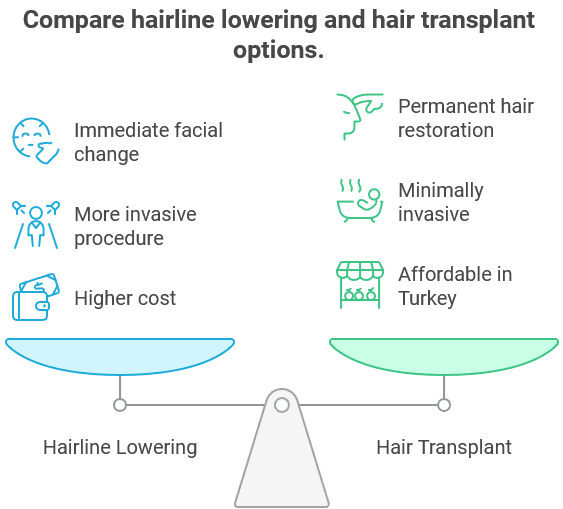A naturally high forehead can lead to a slightly unbalanced look, so while some people see it as a sign of intelligence, a lot of people would prefer to change it. Another reason why it may seem elongated is because of male pattern baldness. Luckily, there are some effective ways to deal with this issue, a hairline lowering or forehead reduction surgery being a particularly popular one.
We will look at who this procedure is for, how it works, and how it compares to a typical hair transplantation.
Did you know?
According to the 2025 ISHRS Practice Census, 84.7% of all surgical hair restoration procedures were performed on men, with the majority undergoing their first procedure between the ages of 26 and 35. With genetic hair loss accounting for over 70% of treatments, it’s no surprise that procedures like hairline lowering and hair transplantation are increasingly popular options for those seeking a more balanced appearance
Who Is a Good Candidate for Hairline Lowering?
There are several causes of a high hairline. For one, a large forehead can just be a genetic component of your overall facial features, but it can also be due to androgenetic or traction alopecia, where thinning and balding are either genetic or caused by hairstyles like tight braids.
In general, ideal candidates for forehead reduction are those who are unsatisfied with the way their forehead looks or have a receding hairline and have good scalp laxity, i.e., stretchy skin in that area. This procedure can be combined with a brow lift for a complete upper-face rejuvenation for middle-aged or older individuals.
Hairline Lowering vs. Hair Transplant: Which Is Right for You?
While you may be a good candidate for forehead reduction, this doesn’t automatically rule out other interventions. For example, if you have a history of hair loss, this operation won’t address the bigger issue, and you will continue to go bald.
A more permanent solution in that case would be a hair transplant, where a new hairline is carefully designed and density restored to the top of the head for a more natural look. The operation is minimally invasive, with a quick recovery time, and affordable in Turkish clinics. It all depends on the individual, though, and if you want to get the best results, you’ll need to consult a professional.
It’s generally a good idea to reach out to clinics, especially those with a highly qualified double board certified plastic surgeon, to get an idea of what the best options for your particular case are.

Hair Transplant After Hairline Lowering: Why Many Patients Do Both
There is also a third option – combining a forehead reduction procedure with a hair transplant in Istanbul. You can experience the benefits of making slight but noticeable changes to your facial structure and tightening the skin, while also getting a complete hair restoration.
Today, you can expect VIP treatment in a reputable Turkish outpatient surgery center and have everything done within a day or two. The top clinics have all-inclusive packages that cover everything from the hotel stay and local transport to the additional PRP treatments and aftercare products, and are significantly less expensive than in the US or Europe.
It will take up to five days post-op for the swelling to go down, so you will need to avoid strenuous activity, but after about two weeks you will be back to your regular lifestyle. The transplanted grafts can also hide the scar left from a hairline lowering procedure, making this a great combination.
It usually takes 6 to 8 months for the new hair to hit a big growth spurt and thicken, and around 12 months for the final results. If you have any questions about these procedures or want to get an assessment, you can schedule a consultation with a doctor specializing in hair transplants at the Asli Tarcan Clinic or a board certified facial plastic surgeon.
FAQs
Should I get a hair transplant instead of Hairline Lowering?
If you have been experiencing hair loss for several years and are in your early to mid-30s or above, it is generally better to go with a transplant. It is quick, minimizes tissue damage, and leaves tiny circular scars around the base of the hair that disappear as soon as it grows out a few millimeters.
However, the results are permanent, and the new hairline will be outlined to follow your natural features and look seamless.
Is it safe to do both procedures?
Yes, as long as you leave enough time between the two operations for the scalp to fully heal. In fact, many people prefer to get a hair transplant a while after their initial hairline correction.
Does a transplant hide the scar from hairline lowering?
As long as you have a good plastic surgeon, there will only be a small straight scar at the hairline. However, if you like wearing your hair slicked back or in a ponytail and want to hide it entirely, a transplant will do an excellent job.
How do I know which is right for me?
Choosing the correct surgical procedure depends on different factors, and it’s best to consult a hair clinic or plastic surgeon.

